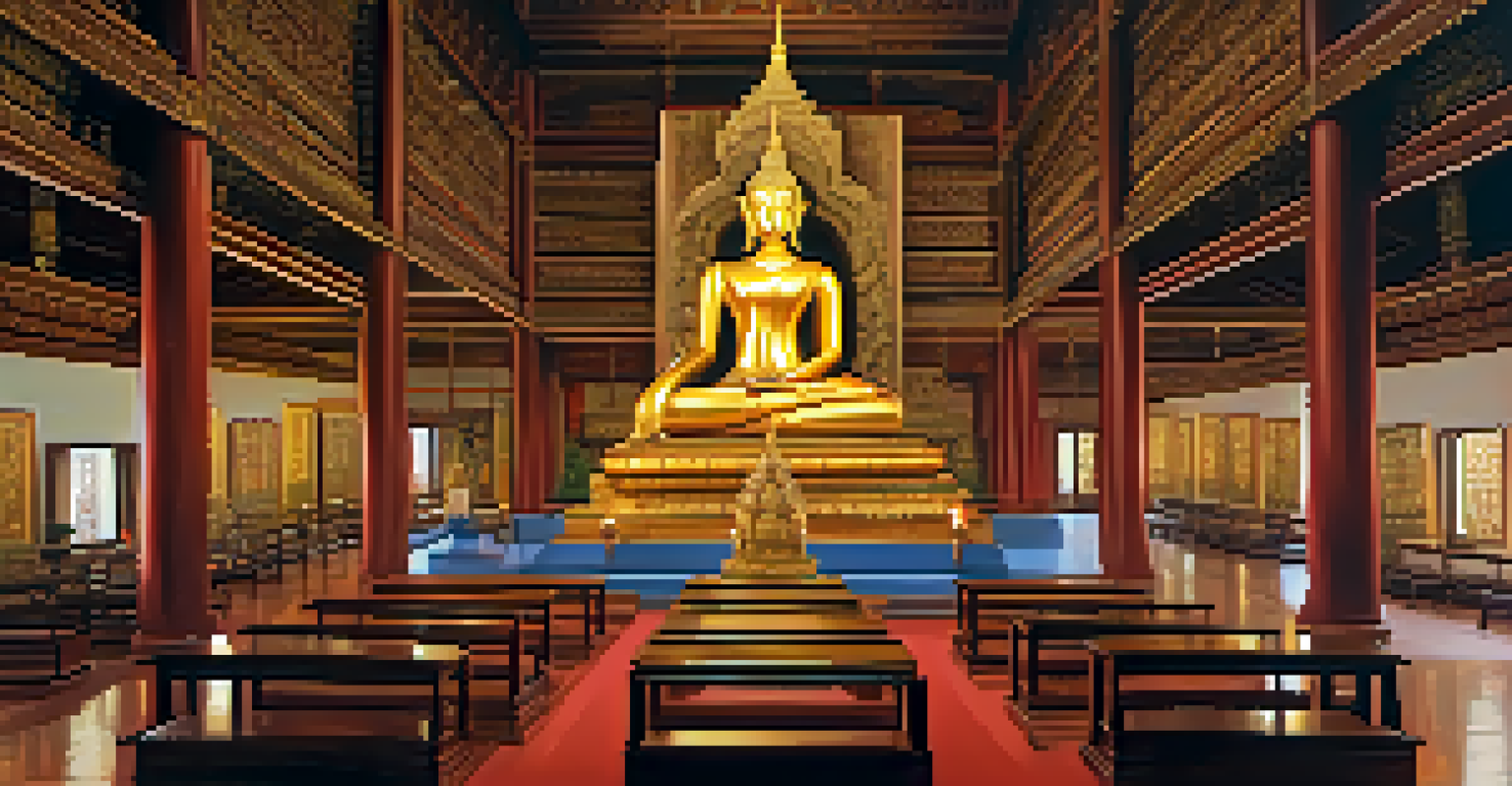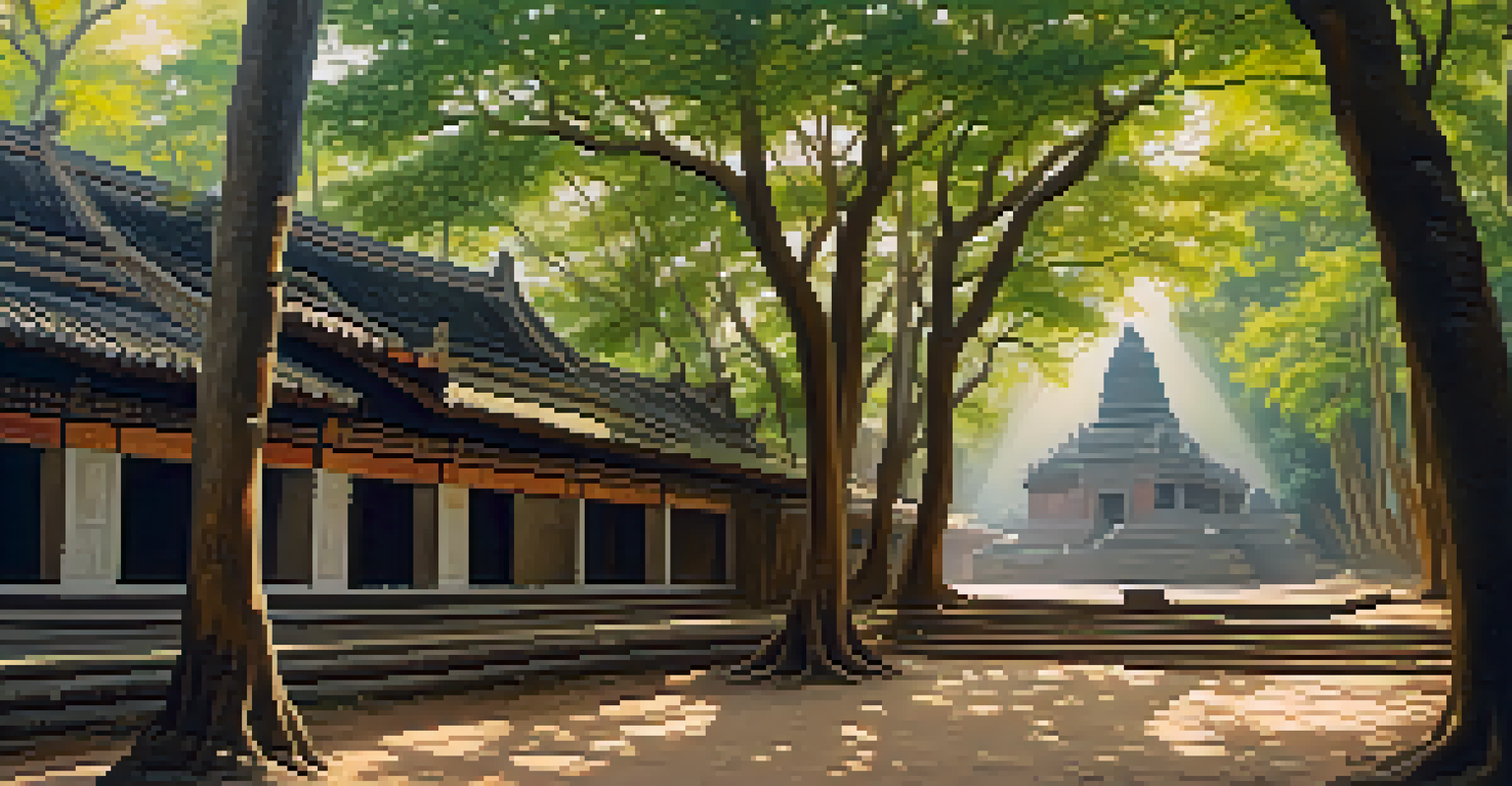Chiang Mai's Temples: A Journey Through Northern Thai Heritage

An Introduction to Chiang Mai's Rich Temple Heritage
Chiang Mai, the cultural capital of Northern Thailand, is home to an incredible array of temples that showcase the region's deep-rooted heritage. Each temple tells a story, reflecting the artistry, spirituality, and history of the Lanna Kingdom. As you wander through the city, you'll encounter a harmonious blend of ancient architecture and vibrant local culture.
Temples are the heart of Thai culture, embodying spirituality and community.
These temples are not just places of worship; they are living museums that offer a glimpse into the past. With their intricate designs and serene atmospheres, they invite visitors to pause and reflect on the traditions that have shaped Chiang Mai. From golden stupas to ornate murals, every detail is a testament to the craftsmanship of the artisans who built them.
Whether you're a history buff or a casual traveler, exploring these sacred sites provides a meaningful way to connect with Northern Thai culture. Each visit opens a window to a world where spirituality and art intertwine, making Chiang Mai a must-visit destination for those seeking a deeper understanding of Thailand's heritage.
Wat Phra That Doi Suthep: A Jewel in the Mountains
Perched high on Doi Suthep mountain, Wat Phra That Doi Suthep is arguably the most iconic temple in Chiang Mai. Its stunning golden stupa glimmers in the sunlight, drawing visitors from all corners of the globe. The journey to the temple, often involving a winding road or a challenging hike, only adds to the sense of adventure and anticipation.

As you ascend, the views of the city below become increasingly breathtaking, making the final destination even more rewarding. Upon reaching the temple, visitors are greeted by a sense of tranquility, enhanced by the gentle sounds of chanting monks and the soft rustle of leaves. The temple's ornate decorations, including intricate carvings and vivid murals, are a feast for the eyes.
Chiang Mai's Temples: Cultural Treasures
The temples of Chiang Mai serve as living museums that reflect the rich heritage and artistry of Northern Thailand.
Beyond its beauty, Wat Phra That Doi Suthep holds significant spiritual importance. Many believe that visiting the temple brings good fortune and blessings, making it a popular pilgrimage site. Engaging with the local customs, such as lighting incense or offering flowers, allows visitors to partake in the rich tapestry of Thai spirituality.
Wat Chedi Luang: A Testament to Resilience
Wat Chedi Luang is a remarkable temple that speaks to the resilience of Chiang Mai's history. Originally built in the 14th century, this temple once housed the Emerald Buddha, Thailand's most revered religious artifact. Though it has weathered earthquakes and the passage of time, the temple stands as a powerful symbol of endurance and cultural significance.
A temple is not just a place of worship; it is a gateway to understanding the rich history and traditions of a culture.
Visitors are often captivated by the massive chedi (stupa) that dominates the temple grounds. Despite the ravages of time, its grandeur is still evident, showcasing the intricate brickwork and unique Lanna architectural style. As you explore the site, the juxtaposition of ancient ruins and ongoing restoration efforts highlights the community's dedication to preserving their heritage.
Wat Chedi Luang also offers a space for reflection and learning. The temple frequently hosts meditation retreats and cultural events, inviting visitors to connect with local traditions. Engaging with the monks and participating in these activities can deepen your appreciation for the spiritual practices that thrive in this sacred space.
Wat Phra Singh: A Sanctuary of Art and Devotion
Wat Phra Singh is renowned not only for its spiritual significance but also for its stunning artistry. This temple is home to some of the most beautiful examples of Lanna architecture, with intricate wood carvings and vibrant murals depicting Buddhist stories. As you step into the temple, the elaborate details draw you into a world of creativity and devotion.
The temple is dedicated to the Phra Singh Buddha, a highly venerated statue believed to bring protection and peace to its followers. Many locals come to offer prayers and seek blessings, creating a lively atmosphere filled with devotion. The sense of community here is palpable, as both locals and tourists come together in appreciation of the temple's beauty and spirituality.
Wat Phra That Doi Suthep's Significance
Wat Phra That Doi Suthep is not only an iconic site for its stunning views and architecture but also a cherished pilgrimage destination for spiritual blessings.
In addition to its artistic and religious significance, Wat Phra Singh hosts various cultural events throughout the year. Festivals, such as Songkran and Loi Krathong, transform the temple grounds into vibrant celebrations filled with music, dance, and traditional rituals. Experiencing these events firsthand allows visitors to immerse themselves in the rich tapestry of Northern Thai culture.
Wat Umong: A Unique Forest Temple Experience
Wat Umong offers a refreshing departure from the bustling city, nestled in a serene forest setting. This temple, known for its ancient tunnels and peaceful ambiance, invites visitors to explore a different side of Chiang Mai's spiritual landscape. The sound of rustling leaves and chirping birds creates a calming backdrop as you wander through the grounds.
The temple's unique design features a series of underground tunnels, originally built as meditation spaces for monks. As you walk through these dimly lit passages, you can feel the history surrounding you. The walls are adorned with faded murals, whispering stories of devotion and contemplation from centuries past.
Wat Umong is also a hub for meditation and mindfulness, attracting those seeking spiritual growth. Visitors can participate in meditation sessions or engage in discussions with resident monks, providing an opportunity to deepen their understanding of Buddhism. This blend of nature, history, and spirituality makes Wat Umong a must-visit for anyone looking to connect with the essence of Northern Thai heritage.
Wat Suan Dok: A Blend of History and Learning
Wat Suan Dok, with its elegant white chedi and sprawling grounds, is a significant temple that serves as both a place of worship and a learning center. Originally built in the 14th century to house the relics of Buddha, it has since become a focal point for Buddhist education in Chiang Mai. The temple's serene atmosphere encourages contemplation and exploration.
One of the unique features of Wat Suan Dok is its role in training monks. The temple frequently hosts meditation workshops and educational programs for both locals and visitors, making it an ideal place to learn about Buddhist practices. Engaging in these activities provides valuable insights into the philosophy and teachings of Buddhism.
Community Role of Temples
Temples in Chiang Mai are vital to the community, offering social gatherings, educational programs, and essential services, thereby reinforcing their integral role in daily life.
The temple grounds are dotted with beautiful white stupas, each representing different members of the royal family. As you stroll through the area, you can feel the historical significance of the site. The combination of rich history, educational opportunities, and stunning architecture makes Wat Suan Dok a noteworthy stop on your journey through Chiang Mai's temples.
The Role of Temples in Chiang Mai's Community Life
Temples in Chiang Mai are not just architectural wonders; they play a vital role in the community's daily life. They serve as gathering places for locals to celebrate festivals, engage in social activities, and participate in religious ceremonies. These events foster a sense of belonging and unity among the residents, strengthening the cultural fabric of the city.
Throughout the year, various festivals are held at the temples, drawing in crowds who come to celebrate and pay homage. Events like Yi Peng, where lanterns are released into the sky, create a mesmerizing spectacle that embodies the spirit of Thai culture. These occasions offer visitors a chance to witness and partake in vibrant traditions that have been passed down through generations.

Moreover, temples often provide essential services to the community, such as education and healthcare. Many temples run schools for local children and offer free medical services to those in need. This commitment to serving the community reinforces the idea that temples are not just places of worship but also integral parts of daily life in Chiang Mai.
Tips for Visiting Chiang Mai's Temples Respectfully
When visiting Chiang Mai's temples, it's essential to approach these sacred spaces with respect and mindfulness. Dress modestly to honor the traditions of the monks and local worshippers. This means covering your shoulders and knees and removing your shoes before entering temple buildings, a practice that reflects the reverence for these spiritual sites.
Be mindful of your behavior while at the temples. Keep your voice low and avoid disruptive actions, as these spaces are often used for meditation and prayer. Observing the local customs, such as bowing slightly when passing by a monk, can enhance your experience and show your appreciation for the culture you are engaging with.
Lastly, take the time to learn about the history and significance of each temple you visit. Engaging with local guides or reading informational plaques can deepen your understanding and appreciation. By approaching your visits with curiosity and respect, you'll leave with not only memories but also a greater connection to Northern Thai heritage.